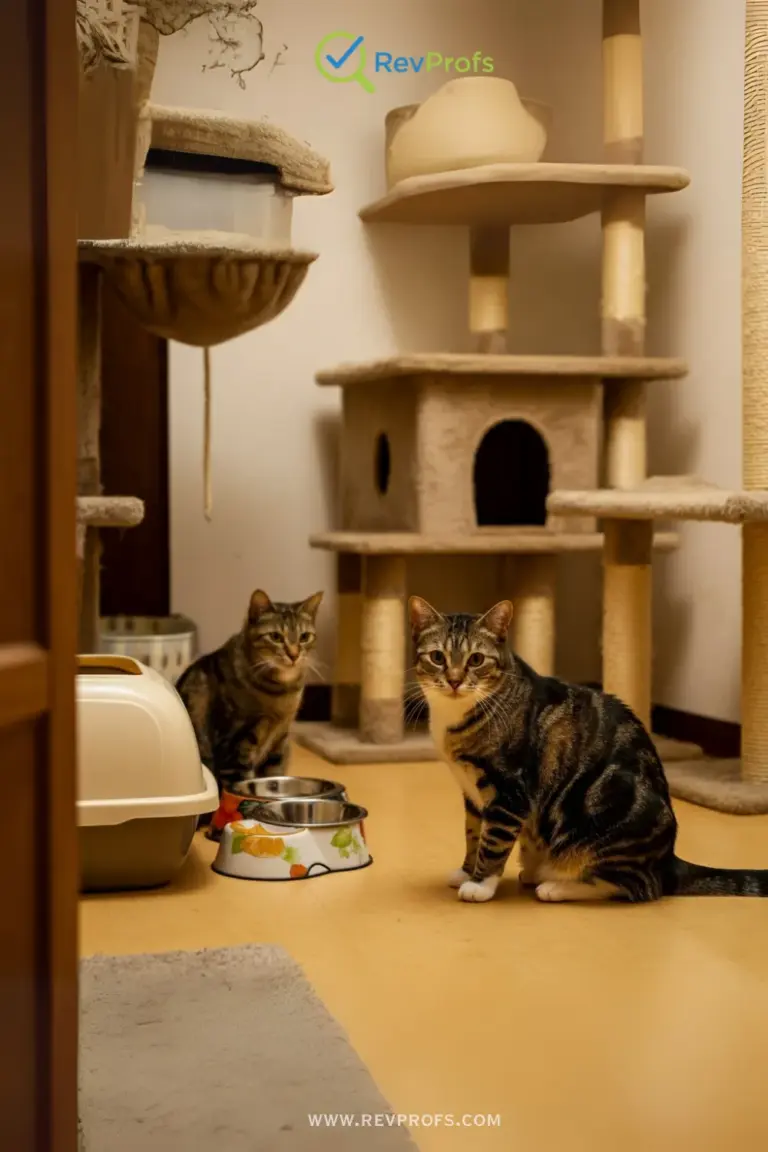How to Correct Cats Bad Behavior: 7 Proven Strategies
Living with a cat brings so much warmth and fun into our homes. But sometimes, their wild instincts can clash with our household rules, leading to some tricky situations. If you’re wondering how to correct cats bad behavior, please know you’re not alone. It can be confusing and frustrating, but the good news is that you can absolutely guide your furry friend toward better habits with kindness and consistency. Understanding your cat is the first step to solving these challenges and making your home a happy place for everyone.
Dealing with ongoing cat behavior problems can test anyone’s patience. It’s important to remember that your cat isn’t trying to be naughty or get revenge. Most of the time, unwanted behaviors are just their way of communicating a need, feeling, or discomfort. By approaching the situation with a little detective work and a lot of love, you can uncover the root cause and find a positive solution. This guide is here to offer you supportive and effective cat training tips to help you and your feline companion live together in harmony.
First, Understand Why Your Cat is Acting Out
Before you can fix a behavior, you need to understand what’s driving it. Cats use their actions to tell us how they’re feeling. Punishing them or yelling will likely only make things worse by causing fear and anxiety, which can weaken the special bond you share.
Instead, let’s try to see the world from their perspective. Ask yourself a few key questions:
- Is something new stressing them out? Changes in the home—like moving furniture, a new family member, or even a different work schedule—can make a cat feel insecure.
- Are they bored? A cat without enough mental and physical stimulation will often find their own (usually destructive) ways to stay entertained.
- Could they be sick? A sudden change in behavior, especially concerning litter box issues, is often the first sign of a medical problem.
For example, a cat that suddenly starts peeing outside the box might have a painful urinary tract infection (UTI). An older cat that becomes grumpy or aggressive could be dealing with arthritis pain. Your very first step for any abrupt behavior change should always be a call to your veterinarian. They can rule out any underlying health issues, giving you peace of mind to focus on behavioral solutions.
How to Correct Cats Bad Behavior
The best way to approach behavior correction is not through punishment, but through management, redirection, and positive reinforcement. The idea is to make the “good” behavior the easy and obvious choice for your cat, while making the “bad” behavior less appealing or impossible. This builds trust and teaches your cat what you want them to do, which is much more effective than just scolding them for what they did wrong.
Let’s explore some of the most effective and humane strategies for common cat behavior challenges.
1. Embrace Positive Reinforcement Cat Training
This is the single most important technique you can learn. Positive reinforcement cat training is all about rewarding the behaviors you want to see more of. When your cat does something right, they get something they love. This makes them more likely to repeat that action in the future. It’s a kind, effective, and fun way to train.
Here’s how to do it:
- Reward instantly: The moment you see your cat use their scratching post instead of the armchair, give them a tasty treat or some enthusiastic praise. The immediate reward helps them connect the action with the positive outcome.
- Find their favorite reward: Figure out what truly motivates your cat. For most, it’s a special, high-value treat they don’t get all the time. For others, it might be a minute of playtime with their favorite wand toy.
- Keep training sessions short: Cats learn best in short, fun bursts. Aim for just a few minutes at a time, once or twice a day. Always end on a high note!
This method transforms training from a chore into a game you both enjoy, strengthening your bond along the way.
2. Solve Litter Box Issues with a Simple Checklist
Nothing disrupts a home quite like a cat who stops using their litter box. But this is a clear signal that something is wrong in their world. Before you get frustrated, run through this checklist.
Common causes and easy fixes:
- Medical First: As mentioned, UTIs, bladder stones, and kidney issues can make using the box painful. Your vet should be your first call to rule this out.
- Keep It Clean: Cats are very clean animals. A dirty box is a major no-go. You should scoop it at least once a day and do a full litter change and box wash weekly.
- Location Matters: The box needs to be in a quiet, low-traffic spot where your cat feels safe and has an escape route. Avoid placing it near a loud washing machine or next to their food and water bowls.
- The Right Setup: A good rule of thumb is to have one litter box per cat, plus one extra. Ensure the box is large enough for your cat to move around in. Some cats have strong preferences for litter texture (clumping vs. non-clumping, scented vs. unscented), so if you recently switched, that could be the problem.
3. Redirect Destructive Scratching
Cat scratching furniture is a completely normal and healthy behavior. They do it to stretch, mark territory with the scent glands in their paws, and shed the outer layer of their claws. You can’t stop a cat from scratching, but you can teach them where it’s okay to do it.
Follow these steps for success:
- Offer better options: Get a few different types of scratching posts—some vertical, some horizontal, made of different materials like sisal rope, cardboard, or carpet. Place them in prominent locations, like next to the sofa they’ve been targeting or near where they sleep.
- Make the furniture unappealing: Gently discourage scratching on your couch by using double-sided sticky tape or special furniture protectors. A citrus-scented spray can also work, as most cats dislike the smell.
- Make the post a party: Rub catnip on the new scratching post or use a feather toy to encourage your cat to play on and around it. When they use it, reward them with praise and a treat!
4. Understand and Manage Cat Aggression
Cat aggression can be frightening, whether it’s aimed at you, another pet, or a visitor. Identifying the cause is crucial to managing it safely.
Common triggers for aggression:
- Play Aggression: This is common in young cats who play too rough because they were never taught boundaries. They might bite or “bunny kick” your hands. Never use your hands as toys! Instead, redirect their energy onto a wand toy or kicker toy.
- Fear-Based Aggression: A frightened cat will hiss, swat, and bite to defend itself. Identify what’s scaring them and work on creating positive associations. Don’t force interactions; let them come to you.
- Redirected Aggression: Sometimes, a cat will see something stimulating outside (like a stray cat) and lash out at the nearest target—which might be you or another pet. If this happens, give them space to calm down before interacting with them.
Never use physical punishment with an aggressive cat. It will only increase their fear and make the aggression worse.

5. Prevent Boredom with an Enriched Environment
A bored cat is often a troublemaker. Many behaviors—like excessive meowing, knocking things over, or picking on other pets—can be a sign that your cat needs more stimulation.
Simple ways to enrich their life:
- Daily Playtime: Schedule at least two 15-minute play sessions each day. Use toys that mimic hunting, like feather wands and laser pointers, to let them stalk, pounce, and “capture” their prey.
- Puzzle Feeders: These toys make your cat work for their food, engaging their brain and satisfying their natural instinct to forage.
- Go Vertical: Cats feel safer when they can view their territory from up high. Cat trees, window perches, or even clear shelves give them great vantage points.
- “Cat TV”: A bird or squirrel feeder placed outside a window can provide endless entertainment.
6. Don’t Reward Attention-Seeking Behavior
Does your cat yowl for breakfast at 4 a.m.? Or walk all over your laptop during a meeting? This is a classic case of attention-seeking behavior. As difficult as it may be, the best thing to do is ignore it completely. If you get up to feed them or shoo them away, you’ve just taught them that making noise works.
Wait for a moment of quiet, and then give them what they want (food, a pet, or playtime). This teaches them that polite behavior, not pestering, gets them your attention.
7. Know When to Ask for Help: Feline Behavior Consultation
Sometimes, a problem is too complex or severe to handle on your own. If you feel overwhelmed or are dealing with serious cat aggression, it may be time to seek a feline behavior consultation.
A certified animal behaviorist or a veterinary behaviorist is an expert who can diagnose the root cause of the issue and create a customized behavior modification plan for you and your cat. Getting professional guidance can be a game-changer, providing you with the tools and support you need. Your veterinarian is a great resource and can often provide a trusted referral.
Remember, correcting your cat’s behavior is a journey, not a race. It requires patience, love, and a willingness to see the world through their eyes. By providing a safe, loving, and stimulating environment, you can build a foundation of trust that will help you overcome any challenge together.
Frequently Asked Questions: Correcting Your Cat’s Behavior
1. Why is my cat suddenly misbehaving?
A sudden change in your cat’s behavior is often their way of telling you something is wrong. The most common reasons include underlying medical issues (like pain or a UTI), stress from a change in their environment (like a new pet or move), or boredom. Your first step should always be a visit to the vet to rule out any health problems. Once medical causes are cleared, you can focus on identifying and managing environmental stressors or providing more enrichment.
2. Is punishment an effective way to stop bad cat behavior?
No, punishing your cat by yelling, spraying water, or using physical force is not effective and can make things worse. Punishment often creates fear and anxiety, which can damage your bond and lead to more severe behavioral issues, including aggression. The best approach is positive reinforcement cat training, where you reward the good behaviors you want to see. This teaches your cat what to do, rather than just scaring them for doing something wrong.
3. How can I stop my cat from scratching my furniture?
You can’t stop a cat’s natural need to scratch, but you can redirect it. To stop cat scratching furniture, you need to do two things: make the furniture a less appealing spot and make a scratching post more attractive.
- Provide great alternatives: Offer several sturdy scratching posts with different textures (sisal rope, cardboard) and orientations (vertical, horizontal).
- Make the post irresistible: Rub catnip on the post and praise your cat with treats whenever they use it.
- Make furniture unappealing: Use double-sided sticky tape or a citrus-scented spray on the areas you want to protect.
4. My cat is avoiding the litter box. What should I do?
Litter box issues are a serious sign that something is amiss. First, see your vet immediately to rule out painful medical conditions like a urinary tract infection. If your cat is healthy, try these cat training tips:
- Keep it clean: Scoop the box daily and wash it with soap and water weekly.
- Check the location: Make sure the box is in a quiet, low-traffic area away from their food.
- Have enough boxes: The rule is one box per cat, plus one extra.
- Experiment with litter: Your cat may have a preference for a certain type of litter. If you recently switched, try going back to the old one.
5. How do I handle play aggression when my cat bites and scratches my hands?
Play aggression is common in young cats, but it’s important to teach them boundaries. The key is to never use your hands or feet as toys.
- Redirect their energy: Always use an interactive toy, like a feather wand or laser pointer, to create distance between your body and their claws.
- End the game: If your cat does bite or scratch you, say “ouch” in a firm voice and immediately walk away to end the play session. This teaches them that biting makes their playmate (you) leave.
6. When should I consider getting professional help for my cat’s behavior?
If you’ve tried these tips and are still struggling, or if your cat is showing signs of serious cat aggression towards people or other pets, it’s time to seek a feline behavior consultation. A certified cat behaviorist or a veterinary behaviorist can help you identify the root cause of the problem and create a customized, step-by-step plan to help your cat and restore harmony in your home. Your veterinarian can be a great resource for a referral.
Ready for the Next Step?
Your pet's journey doesn't end here. Explore our expert guides to ensure they get the best care at every stage.
Puppy & Dog Care
From choosing the right food to understanding their behavior, our dog care guides cover everything you need to know.
Explore Dog GuidesGear & Product Reviews
Find honest, in-depth reviews on the latest pet gear, from smart collars to durable toys, and make informed decisions.
See All Reviews



